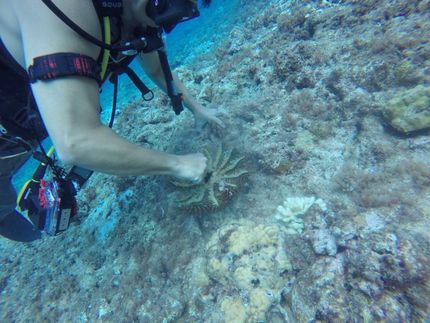Symbiotic bacteria program daily rhythms in squid using light and chemicals
Glowing bacteria inside squids use light and chemical signals to control circadian-like rhythms in the animals, according to a study to be published in mBio®. The Hawaiian bobtail squid, Euprymna scolopes, houses a colony of Vibrio fischeri bacteria in its light organ, using the bacteria at night as an antipredatory camouflage while it ventures out to hunt. The results of the study show that, in addition to acting as a built-in lamp, the bacteria also control when the squid expresses a gene that entrains, or synchronizes, circadian rhythms in animals.
"To our knowledge, this is the first report of bacteria entraining the daily rhythms of host tissues," says corresponding author Margaret McFall-Ngai of the University of Wisconsin - Madison. If bacteria can entrain daily rhythms in an animal, McFall-Ngai says, it's reasonable to think these influences will eventually be found in other animals. It's possible that microbial partners in the human gut, for instance, could similarly influence human daily rhythms through chemical signaling.
Like all animals, squids make proteins that set their inner clock to environmental light. E. scolopes produces two of these "light entrainment" proteins (cryptochromes, or CRYs), and one is regulated in the squid's head, just like every other animal. McFall-Ngai and her co-authors noticed that escry1, the gene that encodes the other protein, is most highly expressed in the light organ, where the squid houses its glowing bacterial symbionts. "The animal uses the luminescence in the evening, so the luminescence is greatest at night. The gene escry1 cycles with the bioluminescence of the animal and not with environmental light," says McFall-Ngai.
But is it the bacterial luminescence that synchronizes the cycling, or is it the bacteria themselves? It's both, says McFall-Ngai.
The bacteria are necessary for cycling, she says, since squid grown without their bacterial symbionts do not cycle their expression of escry1, and mimicking the bacterial light with a blue light did not induce the cycling.
And they showed that the light is also necessary, because squids grown with defective V. fischeri symbionts that lack the ability to luminesce didn't cycle their expression of escry1 either. With light-defective bacteria in their light organs, squids exposed to the blue light got back on track, cycling escry1 production as usual.
What is it about the bacteria that could be signaling to the squid? Long experience taught McFall-Ngai where to turn next: microbe-associated molecular patterns (MAMPs), molecules that signal the presence of microbes to other creatures. "In this system we have found again and again that bacterial surface molecules are active at inducing all kinds of cellular behavior in the host," says McFall-Ngai.
Her hunch was right. MAMPs plus light turned cycling on. In squid grown without symbionts, light, combined with MAMPs (either the lipid A component of lipopolysaccharide or the peptidoglycan monomer), could induce some degree of cycling. The squid did not respond fully, though, maybe because the MAMPs were only injected into their seawater habitat, not presented directly to the light organ.
The fact that a bacterium can control a daily rhythm in a squid is exciting for other areas of biology, says McFall-Ngai, because all animals, including humans, have clock genes like escry1.
"Recently, in two different studies, biologists have found that there is profound circadian rhythm in both the epithelium [of the human gut] and the mucosal immune system of the gut that is controlled by these clock genes. What are we missing? Are the bacteria affected by or inducing the cycling of the tissues with which they associate?" We don't know," says McFall-Ngai, but it's an area ripe for study.
Moving forward with the squid symbiosis, McFall-Ngai says her lab will try to tie in the transcription of escry1 with cycling in the squid's metabolism to see what changes the squid actually experiences while it's under the spell of its bacterial symbionts.
Most read news
Organizations
Other news from the department science

Get the chemical industry in your inbox
By submitting this form you agree that LUMITOS AG will send you the newsletter(s) selected above by email. Your data will not be passed on to third parties. Your data will be stored and processed in accordance with our data protection regulations. LUMITOS may contact you by email for the purpose of advertising or market and opinion surveys. You can revoke your consent at any time without giving reasons to LUMITOS AG, Ernst-Augustin-Str. 2, 12489 Berlin, Germany or by e-mail at revoke@lumitos.com with effect for the future. In addition, each email contains a link to unsubscribe from the corresponding newsletter.


























































